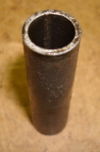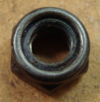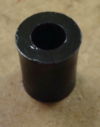Post hole digger
From DDL Wiki
(→Product Function/Evaluation) |
(→Product Function/Evaluation) |
||
| Line 38: | Line 38: | ||
Prior to physically testing the products, we first tried to gauge the maximum amount of pulling force an average human could impart in a pulling motion similar to the pulling action used in operating a post hole digger. In doing this, a small apparatus was created using a compression spring attached with wooden handles on opposite ends. | Prior to physically testing the products, we first tried to gauge the maximum amount of pulling force an average human could impart in a pulling motion similar to the pulling action used in operating a post hole digger. In doing this, a small apparatus was created using a compression spring attached with wooden handles on opposite ends. | ||
| - | [[Image:Post_hole_digger_spring.jpg|300px]][[Image:Post_hole_digger_spring_apparatus.jpg|300px]][[Post_hole_digger_spring_measure. | + | [[Image:Post_hole_digger_spring.jpg|300px]][[Image:Post_hole_digger_spring_apparatus.jpg|300px]][[Post_hole_digger_spring_measure.jpg|300px]] |
While gripping the handles, the spring was then pulled apart with the user exerting the maximum amount of force possible. | While gripping the handles, the spring was then pulled apart with the user exerting the maximum amount of force possible. | ||
Revision as of 18:02, 21 September 2008
Contents |
Executive Summary
Customer Needs and Stakeholders
The post hole digger is a common landscaping equipment. The primary customer need in a post hole digger is to have the ability to inexpensively dig a hole effectively and efficiently for landscaping and various other purposes (such as deploying a fence, erecting a wall, installing lamp posts, etc..). Because this is a heavy duty tool that must undergo large amounts of stresses from breaking soil, the first and foremost requirement is reliability and durability. Oftentimes, digging a hole is simply the foremost and critical step in the grand scheme of a project, and thus the customer will not want to experience a setback in a faulty post hole digger, causing a delay in the entire project. In addition, operating the post hole digger requires constant lifting and carrying, and thus the tool must be of relatively manageable weight to prevent consumer fatigue and discomfort. To reduce weight, the shaft of the post hole digger will oftentimes be made of wood, and in more advanced designs, fiberglass.
Primary Stakeholders and Thier Concerns:
Consumers: There are a wide range of concerns for the users of the post hole digger. Some concern one type of user more than others, and vice versa. However, the main general concern for each user involve the weight of the post hole digger, the cost, the durability, and the effective ease of use. The post hole digger must be light enough to be used repeatedly without causing injury, cheap enough to be a good investment, strong enough not to break under heavy use, and effective enough to warrant purchasing an entire tool solely for digging holes. The following is a breakdown of the main types of users and thier specific concerns:
Landscapers - The most common user, the landscaper primarily uses the tool to erect fences and walls, and thus the post hole digger is used in high frequency. To the landscaper, weight is key as they are constantly digging holes.
Homeowners - These users are categorized as the everyday homeowners who percieve landscaping as a hobby. They use the post hole digger as a tool to maintain thier backyard, but only do so sparingly and when needed. To these users, the cost of the post hole digger is essential, if the price is too high, it will be seen as an unnecesarry investment.
Construction workers - Similar to landscapers, the construction worker utilizes the post hole digger as a compliment to thier everyday work, which typically involve constructing buildings, parks, and other largescale projects. Due to the sheer size and abusive environment these workers are usually in, the post hole digger must be highly durable to withstand the wear and tear associated at these construction sites.
Design Engineers: These stakeholders are the ones who have the most control and effect on the other stakeholders, as they are the ones who design and determine what the product will look like and function. However, there still are some primary concerns that design engineers face. The design must be a quality product that performs the necessary function of what it is desinged to do, in this case it is to dig holes. In addition, they also are concerned with how much material would be going into the design, the more there is, the more costly the final product would be. Also, they also need to design the post hole digger in a way such that it is easy to be manufactured, which is a great concern with the manufacturers.
Manufacturers: As mentioned above, manufacturers are primarily concerned with the ease of manufacturing and assembling the post hole digger. Because the post hole digger will be produced en masse, to the manufacturer the parts of the post hole digger must be interchangeable and must be used of materials that are easy to work with, such as steel and wood. They are also concerned with the cost of production, and the post hole digger should be designed so that simple machining operations such as casting, stamping, and extruding can be used. The design also must not contain any system of design unconventional to the manufacturer, such as extremely tight tolerances and inconsistent units.
Material Providers: Unlike manufacturers, these stakeholders are those whole provide the actual materials to manufactuers to be made into post hole diggers. To them, they are concerned with how well the product actually sells, so that they can provide more materials. There could be a conflict of interest between the materials providers and manufacturers, as the materials providers may want the design to be very inefficient to manufacturer such that more materials must be purchased. This confict of interest must be balanced by the design engineers mentioned above.
Retailers: Finally, the retailers are those who are in charge of selling the actual product to the users, mainly home improvement centers and hardware stores such as Lowes and Home Depot. To them, the primary concerns involve a product that must be durable and attractive. The product must be durable in that there will be less refunds and returns from users, causing a drop in sales and unsatisfied customers. The post hole digger must also be attractive in that it must not look too unconventional or hard to use such that buyers would not know what the tool is used for, and thus not purchase the item.
Product Function/Evaluation
A total of two different post hole digger designs are examined. One is the most basic standard post hole digger manufactured by True Temper, and the other is a more complex post hole digger that utilizes a compound action, also manufactured by True Temper. In all designs, the post hole digger consists of two main shovel blades hinged in a jaw-like arrangement, the shovel blades are open when the handles are closed, and close when the handles are pulled apart.
In this section, both post hole diggers were physically tested outside on both soft and hard soil. This was done to more adequately gauge the performance differences between the two designs under a range of conditions, as well as identify possible areas for improvement.
Initial Testing:
Prior to physically testing the products, we first tried to gauge the maximum amount of pulling force an average human could impart in a pulling motion similar to the pulling action used in operating a post hole digger. In doing this, a small apparatus was created using a compression spring attached with wooden handles on opposite ends.
While gripping the handles, the spring was then pulled apart with the user exerting the maximum amount of force possible.
Operation:
Operating a post hole digger is a simple process that involves some moderatley heavy lifting. The following is an illustrated procedure documenting the operation of both the simple and complex post hole diggers. The performance of the two diggers are then compared side by side.
the post hole digger is initially thrust into the ground while the handles are in the closed position, allowing the shovel blades to effectively draw in soil and earth
Once the shovel blades are fully embedded into the soil, the handles are drawn apart, causing the blades to swivel shut, grasping the soil. Oftentimes for dense earth, the handles must be open and closed a number of times to effectively break the soil to be grasped. Once the handle is shut, the operator will lift up the post hole digger with the captured soil, leaving a round, deep hole in the ground.
Assembly
While simply using a product can give one a better understanding of its operation, examining the individual components and how they are assembled can give further insight. Performing a disassembly also provides a means for determining how the product and its parts were manufactured. With this information, a more extensive analysis can be performed and additional modes of product improvement can be discovered.
Simple Post Hole Digger
The simple post hole digger is assembled from 24 parts, though there are only 8 unique components in the assembly. These 8 components were documented and can be seen, along with descriptions and other useful information, in Table 1.
The simple post hole digger has wooden handles, which are common on many hand operated landscaping implements due to the strength, low weight, and low cost of wood. The digging heads are made of stamped steel, which is also strong, low cost, and easy to form. The connections between the handles and the digging heads are made with bolts, which are very common fasteners that have low cost and high strength. An exploded view of these major components can be seen in Figure _.
Complex Post Hole Digger
The complex post hole digger is assembled from 44 parts, which consist of multiples of 19 unique components. Descriptions and other useful information about these 19 components were documented and can be seen in Table 2.
The complex post hole digger has a composite handle made of several materials. The portion that the user grips is made from a coated fiberglass tube. This style of handle is also popular in gardening and landscaping equipment, due to its light weight and high strength. The fiberglass handle is joined to a tubular steel handle extension. The steel/fiberglass connection is reinforced with a round wood insert. This insert fits inside the hollow fiberglass tube and fills the bottom 1/3 of the handle (see figure). This wooden insert is necessary to strengthen the bolted connection between the steel tube and the fiberglass.
The lower portion of the handle is made of round steel tubing. There are multiple bends required to create the scissoring action of the tool, and steel tubing is a good material for bending and forming into complex shapes like this. Steel is also very strong and can withstand the forces applied while digging. Like the simple post hole digger, the digging heads are made of stamped steel, which is strong, low cost, and easy to form. The connections between parts are made with bolts, which, as mentioned previously, are common, low cost, high-strength fasteners.























